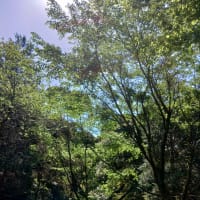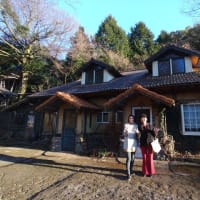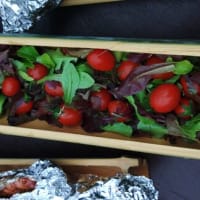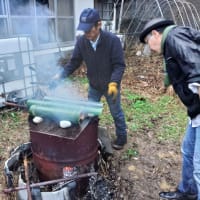いよいよ始まった。
シンガポールに本社置くインド系のリサーチ&コンサルタント会社”BRCORP”と
NPO法人『インターナショナル・プロジェクト協会(IPA)』との
具体的行動指針が昨夜幹部を集めて話し合われた。

国際ビジネスだ。
話の内容は大きい。
基本的には産学協同事業を柱とする3本柱から成り立つ。
① Consultant 事業
② Conference 事業 (Event managiment)
③ Publication 事業
すべての事業はTechnologyを核に展開される。
その範囲は、環境問題から、化学、土木工学、医療関係にまで上る。
まずは地道な大学との連携を図るところから始まる。
教授たちの研究を手助けするのだ。
そこで各企業と結びつける役割を担う。
ボクは、日本の大学との連携役だ。
さらにボクの企画が先日の訪越で、遡上に上った。
それは、環境&エネルギー問題と絡めたバイオマス開発事業だ。
ハノイとホーチミンの大学教授が、ボクの提唱するコーヒー粕からのバイオ燃料を作る事業に興味を持った。
技術は既に日本で開発されている。
そこに、ODA資金とJICAによる人的派遣を組み合わせれば実現可能だ。
場所は、コーヒーの生産地に近いベトナム中部が有力とされる。
これはまさに先日ボクが訪れて多くの人脈を構築したところだ。
狙いと行動がはからずも一致した。
これはまさに国家事業(ナショナル プロジェクト)だ。
ベトナム政府と日本政府に動いてもらわなければならない。
もちろん、採算性を考慮した上でだが。
さて、Conference部門においては、
来年9月、ネパールのカトマンズでテクノ会議が催される。
そこへの出席も要請が来ている。
まさに世界を股にかけた一大プロジェクトが始まろうとしている。
準備は着々と進んでいる。
同士も募っている。
興味を持った人は集結して欲しい。
次のNPO総会は、27日に予定している。
そこで会おう。
来たれ有志たちよ。
【参考文献】
ネパールの新聞(カトマンズ・ポスト)です。
来年9月カトマンズでBRCORP主催で開かれる国際会議のニュースです。
Kathmandu Post
Kantipur
Date | Wednesday, Nov 13, 2013 Login | Register
Jump to : Home
News
Editorial
Sports
MONEY
et cetera
Pragyan Bhattarai KATHMANDU, NOV 11 -
Environment is the main component of the earth system. The overuse and abuse of different components of the environment is threatening the survival of human beings. Global warming, increase in pollution, unusual calamities and other tantamount effects are the outcomes of the degradation of component of environment. The life span of living beings is decreasing year after year because of exposure to many chemicals.
In the name of sophistication we are degrading the environment to the extent that we could be in very difficult circumstance at any instant. If we continue to carry on with what we are doing and do not take any preventive or control measures, we may end in an irreversible situation. So the need of the hour is to think seriously about protecting the environment and live a good life in the future. It’s time to think for eco-friendly and locally alternatives.
Environmental progress concept was started in 1970s and later culminated in the green revolution in 1990, which raised the attention of the need for preservation of environment and the role of human activities for environmental protection. Many developing countries are working for eco-friendly materials and are trying to spread awareness for optimum utilisation of locally available materials and eco-friendly materials. In spite of all this, there is hardly any noticeable improvement. Developing countries are still struggling to embrace the concept and hence the implementation of eco-friendly materials has made almost no progress.
Development activities in developing countries like Nepal, India, Bhutan are getting along at a fast pace. It is believed that the growth rate of the construction industry in India, covering around 5 percent of the globe, is around 9.5 percent. The developing countries use many non-renewable resources resulting in large scale of deforestation. It is imperative that the construction industry resorts to using eco-friendly materials to protect the environment.
Today’s achievements in technology have influenced the environment. It is obvious that people wish to live in eco-friendly houses and lead a healthy lifestyle. Optimum utilisation of natural and locally available materials can be an answer. In developing countries, the use of technology in ample amount is difficult and locally available materials can help own an eco-friendly house.
In this context, straw houses can be one of the best alternatives for a country like Nepal where agriculture is still the main source of income and production of straw is tremendous. The present scenario reflects those straws are either burned or ploughed back to soil leading to the production of harmful gas as carbon forming black cloud. Straw bale construction can be one of the best alternatives as it is renewable resources having tremendous features as cost effective with high health value, fire resistance, light weight and eco-friendly. We also can go with various techniques of construction as load bearing straw bale construction (structural bale house) or non-load bearing (light weight frame and non-structural house) construction as per the circumstances.
Straw is a natural fiber of the plant structure between the root crown and the grain head. It is being produced by the process of photosynthesis, a natural and non-polluting process by solar energy. We can get this from wheat, rice, oats, hops and barley. Among them rice straw is the toughest one due to high silica content. It is an annually renewable agricultural residue, which is being produce in most of the countries. Studies shows that world largest straw producing countries like China, India have not been able to utilise it. In India, it is used for the production of papers and some other purposes, but this alone is not enough for its proper utilisation.
Straw bale is simply a compressed bundle of straw, which is arranged in square, rectangular or round shape attached with wire or twins. Straw is the dry steams of cereal grains left after seed heads are removed. Bale density varies according to the type of grains and moisture level, among other things. A straw bale wall weighs 65 percent less than an equivalent brick wall and 62 percent less than a concrete block wall.
A study of straw bale shows that it is highly eco-friendly in its production, placement, function and operation and maintenance to reconstruction and moreover it’s economical than the normal one which we are using nowadays. It depicts that it is produced in environment and it requires low energy for procurement for comfort, creativity and aesthetics.
The pace of development and rising need of people is increasing day by day, which ultimately has increased impacts on the environment. Human activities, especially in the construction industry, affect various components of the environment. So working in collaboration with the environment must be the main motto of today’s world. Use of eco-friendly materials is only the mean to get this done. Straw bale can be one of the promising building materials that meet the overall housing needs and energy efficient goals of most of the developing countries like India, Nepal, Bhutan etc, where agriculture act as the backbone of development. Nepal also produces straw, but most of those is considered as waste and limited are only used for productive type but if we can utilise them for construction in the form of straw bale then staying in good house won’t be limited to dream for people. It aids to maintain the quality of living stander of people because straw house fulfills serviceability and helps to maintain the environmental quality.
Straw is getting lots of preference in many countries because of its cost effectiveness with high health value, aesthetics value, thermal performance, fire resistance, light weight and eco-friendly in nature. It also has good response against earthquakes so it can be constructed in quake-prone areas as well. Many alternative materials like straw bale still exists in Nepal, those must be identified, proper research for its application must be done. To make all this possible, community awareness programmes should be conducted to educate people about the resources and energy and the need and advantages of using alternative eco-friendly materials. All the polluting industries should be encouraged to implement the green concept to reduce pollution to save the environment.
The government should encourage the use of eco-friendly materials by providing subsidies or free consultations. The authorities and banks should help the poor and middle class people by giving loans and subsidies as they can’t afford the high technology due to cost factors. This approach can be spread by updating the ‘eco-friendly material in construction’ content in their courses right from the primary school level. Various programmes, conferences and training workshops must be launched on a regular basis to get best exposure to new and innovative materials available locally.
(Bhattarai is Civil Engineer at Basha Research Cooperation, Singapore and Assistant Editor-in-Chief of International Journal of Engineering Research and General Science)
Posted on: 2013-11-12 09:56
--------------------------------------------------------------------------------
シンガポールに本社置くインド系のリサーチ&コンサルタント会社”BRCORP”と
NPO法人『インターナショナル・プロジェクト協会(IPA)』との
具体的行動指針が昨夜幹部を集めて話し合われた。

国際ビジネスだ。
話の内容は大きい。
基本的には産学協同事業を柱とする3本柱から成り立つ。
① Consultant 事業
② Conference 事業 (Event managiment)
③ Publication 事業
すべての事業はTechnologyを核に展開される。
その範囲は、環境問題から、化学、土木工学、医療関係にまで上る。
まずは地道な大学との連携を図るところから始まる。
教授たちの研究を手助けするのだ。
そこで各企業と結びつける役割を担う。
ボクは、日本の大学との連携役だ。
さらにボクの企画が先日の訪越で、遡上に上った。
それは、環境&エネルギー問題と絡めたバイオマス開発事業だ。
ハノイとホーチミンの大学教授が、ボクの提唱するコーヒー粕からのバイオ燃料を作る事業に興味を持った。
技術は既に日本で開発されている。
そこに、ODA資金とJICAによる人的派遣を組み合わせれば実現可能だ。
場所は、コーヒーの生産地に近いベトナム中部が有力とされる。
これはまさに先日ボクが訪れて多くの人脈を構築したところだ。
狙いと行動がはからずも一致した。
これはまさに国家事業(ナショナル プロジェクト)だ。
ベトナム政府と日本政府に動いてもらわなければならない。
もちろん、採算性を考慮した上でだが。
さて、Conference部門においては、
来年9月、ネパールのカトマンズでテクノ会議が催される。
そこへの出席も要請が来ている。
まさに世界を股にかけた一大プロジェクトが始まろうとしている。
準備は着々と進んでいる。
同士も募っている。
興味を持った人は集結して欲しい。
次のNPO総会は、27日に予定している。
そこで会おう。
来たれ有志たちよ。
【参考文献】
ネパールの新聞(カトマンズ・ポスト)です。
来年9月カトマンズでBRCORP主催で開かれる国際会議のニュースです。
Kathmandu Post
Kantipur
Date | Wednesday, Nov 13, 2013 Login | Register
Jump to : Home
News
Editorial
Sports
MONEY
et cetera
Pragyan Bhattarai KATHMANDU, NOV 11 -
Environment is the main component of the earth system. The overuse and abuse of different components of the environment is threatening the survival of human beings. Global warming, increase in pollution, unusual calamities and other tantamount effects are the outcomes of the degradation of component of environment. The life span of living beings is decreasing year after year because of exposure to many chemicals.
In the name of sophistication we are degrading the environment to the extent that we could be in very difficult circumstance at any instant. If we continue to carry on with what we are doing and do not take any preventive or control measures, we may end in an irreversible situation. So the need of the hour is to think seriously about protecting the environment and live a good life in the future. It’s time to think for eco-friendly and locally alternatives.
Environmental progress concept was started in 1970s and later culminated in the green revolution in 1990, which raised the attention of the need for preservation of environment and the role of human activities for environmental protection. Many developing countries are working for eco-friendly materials and are trying to spread awareness for optimum utilisation of locally available materials and eco-friendly materials. In spite of all this, there is hardly any noticeable improvement. Developing countries are still struggling to embrace the concept and hence the implementation of eco-friendly materials has made almost no progress.
Development activities in developing countries like Nepal, India, Bhutan are getting along at a fast pace. It is believed that the growth rate of the construction industry in India, covering around 5 percent of the globe, is around 9.5 percent. The developing countries use many non-renewable resources resulting in large scale of deforestation. It is imperative that the construction industry resorts to using eco-friendly materials to protect the environment.
Today’s achievements in technology have influenced the environment. It is obvious that people wish to live in eco-friendly houses and lead a healthy lifestyle. Optimum utilisation of natural and locally available materials can be an answer. In developing countries, the use of technology in ample amount is difficult and locally available materials can help own an eco-friendly house.
In this context, straw houses can be one of the best alternatives for a country like Nepal where agriculture is still the main source of income and production of straw is tremendous. The present scenario reflects those straws are either burned or ploughed back to soil leading to the production of harmful gas as carbon forming black cloud. Straw bale construction can be one of the best alternatives as it is renewable resources having tremendous features as cost effective with high health value, fire resistance, light weight and eco-friendly. We also can go with various techniques of construction as load bearing straw bale construction (structural bale house) or non-load bearing (light weight frame and non-structural house) construction as per the circumstances.
Straw is a natural fiber of the plant structure between the root crown and the grain head. It is being produced by the process of photosynthesis, a natural and non-polluting process by solar energy. We can get this from wheat, rice, oats, hops and barley. Among them rice straw is the toughest one due to high silica content. It is an annually renewable agricultural residue, which is being produce in most of the countries. Studies shows that world largest straw producing countries like China, India have not been able to utilise it. In India, it is used for the production of papers and some other purposes, but this alone is not enough for its proper utilisation.
Straw bale is simply a compressed bundle of straw, which is arranged in square, rectangular or round shape attached with wire or twins. Straw is the dry steams of cereal grains left after seed heads are removed. Bale density varies according to the type of grains and moisture level, among other things. A straw bale wall weighs 65 percent less than an equivalent brick wall and 62 percent less than a concrete block wall.
A study of straw bale shows that it is highly eco-friendly in its production, placement, function and operation and maintenance to reconstruction and moreover it’s economical than the normal one which we are using nowadays. It depicts that it is produced in environment and it requires low energy for procurement for comfort, creativity and aesthetics.
The pace of development and rising need of people is increasing day by day, which ultimately has increased impacts on the environment. Human activities, especially in the construction industry, affect various components of the environment. So working in collaboration with the environment must be the main motto of today’s world. Use of eco-friendly materials is only the mean to get this done. Straw bale can be one of the promising building materials that meet the overall housing needs and energy efficient goals of most of the developing countries like India, Nepal, Bhutan etc, where agriculture act as the backbone of development. Nepal also produces straw, but most of those is considered as waste and limited are only used for productive type but if we can utilise them for construction in the form of straw bale then staying in good house won’t be limited to dream for people. It aids to maintain the quality of living stander of people because straw house fulfills serviceability and helps to maintain the environmental quality.
Straw is getting lots of preference in many countries because of its cost effectiveness with high health value, aesthetics value, thermal performance, fire resistance, light weight and eco-friendly in nature. It also has good response against earthquakes so it can be constructed in quake-prone areas as well. Many alternative materials like straw bale still exists in Nepal, those must be identified, proper research for its application must be done. To make all this possible, community awareness programmes should be conducted to educate people about the resources and energy and the need and advantages of using alternative eco-friendly materials. All the polluting industries should be encouraged to implement the green concept to reduce pollution to save the environment.
The government should encourage the use of eco-friendly materials by providing subsidies or free consultations. The authorities and banks should help the poor and middle class people by giving loans and subsidies as they can’t afford the high technology due to cost factors. This approach can be spread by updating the ‘eco-friendly material in construction’ content in their courses right from the primary school level. Various programmes, conferences and training workshops must be launched on a regular basis to get best exposure to new and innovative materials available locally.
(Bhattarai is Civil Engineer at Basha Research Cooperation, Singapore and Assistant Editor-in-Chief of International Journal of Engineering Research and General Science)
Posted on: 2013-11-12 09:56
--------------------------------------------------------------------------------




























